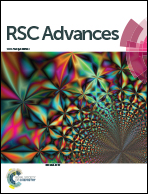Mercaptooxazole–phenazine based blue fluorescent sensor for the ultra-sensitive detection of mercury(ii) ions in aqueous solution†
Abstract
Herein, a mercury(II) ion fluorescent sensor (Z-3) with high sensitivity and immediate response is designed and synthesized. The sensor uses the phenazine group as a luminophore and sulfhydryl as a recognition moiety. The sensor is easily synthesized and it exhibits a remarkable blue shift with Hg2+. Correspondingly, its fluorescence color changes from yellow to blue. In addition, the low naked eye detection limit (10−5) of the sensor allows the identification of concentration limits. Moreover, the sensor could detect mercury(II) ions over a wide pH range (from 2 to 8), which indicates that the detection can be carried out in aqueous systems. In addition, test strips are fabricated, which could act as a convenient pathway for the recognition of Hg2+.

- This article is part of the themed collection: Editors’ collection: Fluorescent Sensors


 Please wait while we load your content...
Please wait while we load your content...